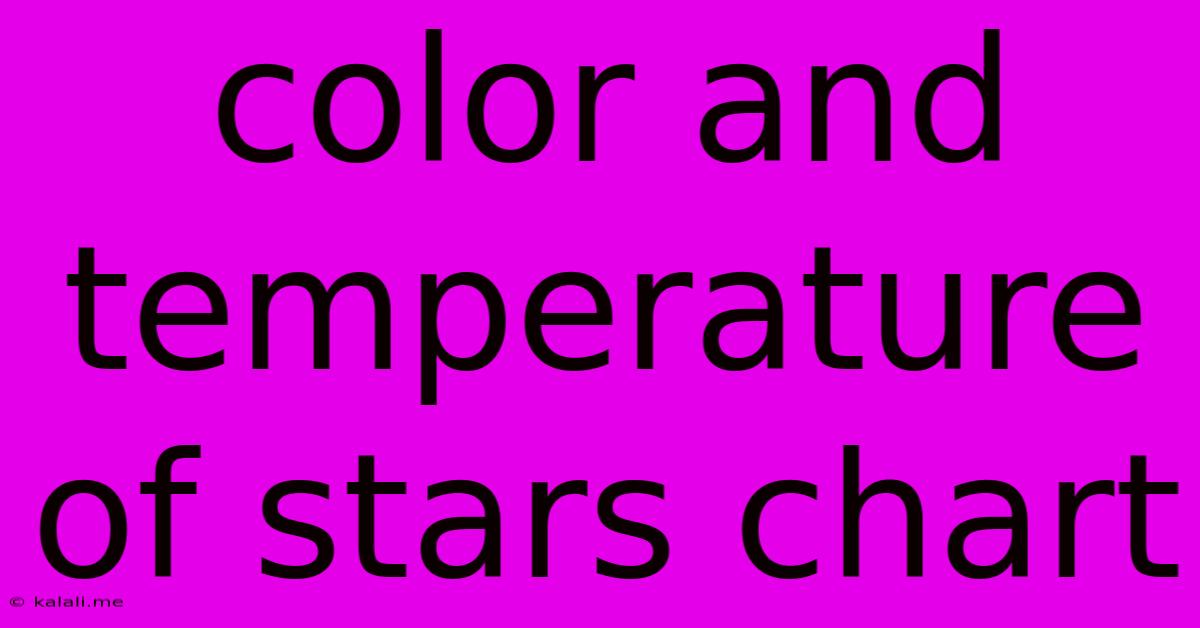Color And Temperature Of Stars Chart
Kalali
May 09, 2025 · 3 min read

Table of Contents
Decoding the Cosmos: A Guide to the Color and Temperature of Stars
Understanding the vastness of space often begins with appreciating the seemingly simple differences between stars. While they all appear as twinkling points of light from our vantage point, stars vary dramatically in their characteristics. One of the most readily observable differences is their color, which is directly related to their surface temperature. This article explores the relationship between a star's color and its temperature, providing a helpful guide to understanding this fascinating aspect of stellar astronomy. We'll also delve into how astronomers classify stars based on this vital characteristic.
The Relationship Between Color and Temperature:
The color of a star is a crucial indicator of its surface temperature. This is governed by a principle of physics known as Blackbody Radiation. Essentially, hotter objects emit more energy at shorter wavelengths of light. This translates to a visible shift in color.
-
Blue Stars: These are the hottest stars, with surface temperatures exceeding 25,000 Kelvin (K). Their intense heat causes them to emit a significant portion of their radiation in the blue and ultraviolet parts of the electromagnetic spectrum. Examples include Rigel and Spica.
-
Blue-White Stars: Slightly cooler than blue stars, blue-white stars still boast impressively high temperatures, ranging from 10,000 K to 25,000 K. Sirius is a prime example of this stellar class.
-
White Stars: These stars represent a mid-range temperature, typically between 7,500 K and 10,000 K. Our own Sun falls into this category.
-
Yellow Stars: Our Sun is a yellow star, indicating a surface temperature of approximately 5,500 K to 7,500 K. Yellow stars are relatively common and often host planetary systems.
-
Orange Stars: Cooler than yellow stars, orange stars have surface temperatures between 3,700 K and 5,500 K. Arcturus is a well-known example.
-
Red Stars: These are the coolest stars on this list, with surface temperatures typically ranging from 2,400 K to 3,700 K. Betelgeuse is a prominent red supergiant. Red dwarfs, the most common type of star in the galaxy, are even cooler, often less than 3,500 K.
The Hertzsprung-Russell Diagram: A Visual Representation:
Astronomers use a tool called the Hertzsprung-Russell (H-R) Diagram to visually represent the relationship between a star's temperature (often shown on the horizontal axis, typically inversely related to spectral type, going from hot to cool) and its luminosity (brightness, often shown on the vertical axis). This diagram is instrumental in classifying stars and understanding their evolutionary stages. The color of a star is directly related to its position on the H-R diagram, providing further insights into its properties.
Beyond Color: Spectral Classification:
While color provides a quick assessment of a star's temperature, astronomers use more precise methods to classify stars. Spectral analysis examines the light emitted by a star, revealing the presence of specific elements and their relative abundances. This information, combined with the star's temperature, allows for a more accurate classification based on spectral type, which uses letters (O, B, A, F, G, K, M) and further subdivisions to indicate subtle differences in temperature and chemical composition.
Conclusion:
The color of a star is a direct result of its surface temperature, reflecting the star's energy output and ultimately its place in the stellar lifecycle. By understanding this relationship, and using tools like the H-R diagram and spectral analysis, astronomers can gain crucial insights into the properties, composition, and evolution of stars across the universe. Observing the night sky with this knowledge deepens our appreciation of the incredible diversity and complexity of the cosmos.
Latest Posts
Latest Posts
-
What Percentage Is 25 Of 60
May 10, 2025
-
Power Went Out For A Second
May 10, 2025
-
What Is The Prime Factorization For 15
May 10, 2025
-
1 Out Of 14 As A Percentage
May 10, 2025
-
What Is The Square Root Of 205
May 10, 2025
Related Post
Thank you for visiting our website which covers about Color And Temperature Of Stars Chart . We hope the information provided has been useful to you. Feel free to contact us if you have any questions or need further assistance. See you next time and don't miss to bookmark.